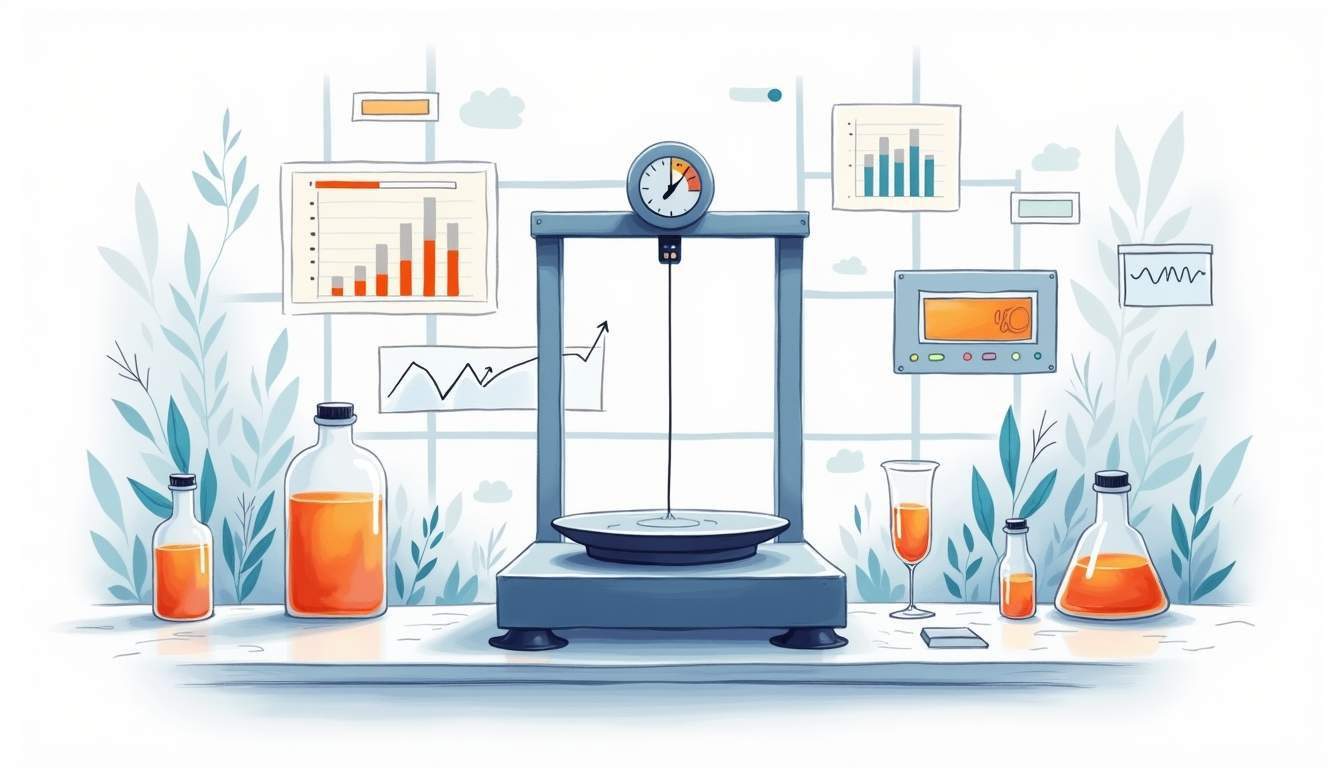
Imagine a production line where every gram counts, and even the slightest deviation in weight can lead to costly errors or safety hazards. Weighing systems are the silent workhorses behind countless industries, from pharmaceuticals to food processing. But how can these systems be made more reliable and insightful? The answer lies in integrating quality indicators directly into the weighing process.
Understanding the Role of Quality Indicators in Weighing
Weighing systems have traditionally focused on delivering accurate measurements. However, accuracy alone doesn’t guarantee quality. Quality indicators provide an additional layer of information that helps operators and automated systems assess the reliability and consistency of each measurement.

These indicators can include parameters such as measurement stability, repeatability, and environmental factors affecting the weighing process. By monitoring these variables, it becomes possible to detect anomalies early, reduce errors, and maintain high standards throughout production. For instance, in a pharmaceutical setting, even the slightest deviation in weight can have significant implications for dosage accuracy, making the role of quality indicators even more critical.
What Are Quality Indicators?
Quality indicators in weighing refer to metrics or signals that reflect the condition and reliability of the weighing process. They go beyond just displaying the weight value; they provide context about how trustworthy that value is at any given moment.
For example, a quality indicator might show if the scale is experiencing vibrations, if the weight reading is fluctuating, or if the tare function was properly applied. These insights can prevent faulty data from being used downstream, which is crucial in industries where precision is non-negotiable. Furthermore, advanced weighing systems can integrate real-time monitoring of these indicators, allowing for immediate adjustments and interventions, thereby enhancing operational efficiency and product quality.
Why They Matter
Without quality indicators, operators might rely solely on the displayed weight, unaware of underlying issues that could compromise the measurement. This can lead to product recalls, regulatory non-compliance, or safety incidents.
Incorporating quality indicators helps establish trust in the weighing system, enabling better decision-making and process control. It also facilitates compliance with industry standards and customer expectations by documenting measurement quality. Additionally, the presence of robust quality indicators can serve as a competitive advantage, as companies that prioritize measurement integrity are often viewed more favorably by clients and regulatory bodies alike. This not only fosters customer loyalty but also enhances a company’s reputation in the marketplace, ultimately contributing to long-term success. To explore our range of weighing systems with advanced quality indicators, follow the following link: https://scales4u.co.za/
Types of Quality Indicators in Weighing Systems
Quality indicators come in various forms, each serving a unique purpose in enhancing weighing accuracy and reliability.
Stability Indicators
One of the most common quality indicators is the stability indicator. It signals whether the weight on the scale has stabilized enough to provide a reliable reading. For instance, if the weight fluctuates due to vibrations or air currents, the stability indicator alerts the user to wait before recording the measurement.
This simple yet effective indicator reduces errors caused by premature readings and ensures that only consistent data is captured. In high-precision environments, such as laboratories or manufacturing facilities, the importance of stability cannot be overstated. Operators are often trained to recognize the significance of this indicator, as it can be the difference between an accurate measurement and one that leads to costly errors. Additionally, some advanced weighing systems may feature visual or auditory signals to enhance user awareness of stability, further reinforcing the need for careful measurement practices.
Repeatability Metrics
Repeatability refers to the ability of the weighing system to produce the same result under identical conditions. Quality indicators can track repeatability by comparing multiple measurements of the same item and flagging inconsistencies.
When repeatability is poor, it signals potential issues with the scale’s calibration, environmental interference, or mechanical problems. Early detection allows for timely maintenance or recalibration, preventing faulty measurements from affecting production. Furthermore, many modern weighing systems come equipped with software that can analyze historical data to identify trends in repeatability over time. This data-driven approach not only aids in immediate troubleshooting but also helps organizations develop long-term strategies for improving their weighing processes, ensuring that they maintain the highest standards of quality control.
Environmental Condition Monitors
External factors such as temperature, humidity, and vibration can significantly impact weighing accuracy. Some advanced systems include sensors that monitor these environmental conditions and integrate their readings into quality indicators.
For example, a sudden temperature change might cause a scale’s components to expand or contract, affecting measurements. By alerting operators to such conditions, the system helps maintain measurement integrity. Moreover, integrating environmental condition monitors can also enhance compliance with industry regulations, particularly in sectors like pharmaceuticals and food production, where strict standards govern operational environments. These monitors can provide real-time data that not only assists in maintaining optimal conditions but also generates reports that can be crucial for audits and quality assurance processes, thereby reinforcing the credibility of the weighing system and the data it produces.
Implementing Quality Indicators: Practical Considerations
Adding quality indicators to a weighing system is not just about installing new sensors or software. It requires thoughtful integration and user training to maximize benefits.

Choosing the Right Indicators
Not every quality indicator is necessary for every application. The choice depends on the industry, the precision required, and the specific challenges faced during weighing.
For example, a pharmaceutical manufacturer might prioritize stability and repeatability indicators due to strict regulatory requirements, while a food processor might focus more on environmental monitoring to handle varying production conditions.
Additionally, it is crucial to consider the potential for future scalability when selecting quality indicators. Industries are constantly evolving, and the demands for higher efficiency and compliance can change rapidly. By choosing indicators that not only meet current needs but also allow for future enhancements, businesses can avoid costly overhauls and ensure long-term viability in their quality management strategies.
Integrating with Existing Systems
Many weighing systems are part of larger automation and quality control frameworks. Quality indicators should be compatible with these systems to allow seamless data exchange and centralized monitoring.
Modern weighing instruments often come with communication protocols like Ethernet/IP, Modbus, or OPC UA, enabling integration with manufacturing execution systems (MES) or supervisory control and data acquisition (SCADA) systems. This connectivity allows real-time quality data to be analyzed alongside other production metrics.
Moreover, the integration process can also enhance predictive maintenance capabilities. By continuously monitoring quality indicators, organizations can identify trends that may indicate potential equipment failures before they occur. This proactive approach not only reduces downtime but also extends the lifespan of the weighing equipment, ensuring that operations remain smooth and efficient.
Training and User Interface Design
Quality indicators are only useful if operators understand and trust them. Clear, intuitive displays and alerts help ensure that users respond appropriately to quality signals.
Training programs should include explanations of what each indicator means, how to interpret them, and the steps to take when an indicator signals a problem. This empowers operators to maintain consistent quality and reduces downtime caused by misinterpretation or neglect.
In addition to formal training sessions, ongoing support and resources can further enhance user confidence. Creating a knowledge base or a quick-reference guide can serve as a valuable tool for operators, allowing them to quickly troubleshoot issues or refresh their understanding of the indicators. Incorporating feedback from users into the design of the user interface can also lead to improvements that make the system more user-friendly, ensuring that quality indicators are not just functional but also accessible to all levels of staff.
Benefits of Quality Indicators in Weighing Systems
Incorporating quality indicators transforms weighing systems from simple measurement tools into intelligent quality control assets.
Improved Accuracy and Reliability
By continuously monitoring measurement conditions and signaling potential issues, quality indicators help maintain high accuracy levels. This reduces the risk of errors that can lead to product defects or regulatory violations.
Enhanced Process Control
Quality indicators provide real-time feedback that can be used to adjust processes dynamically. For example, if environmental conditions are affecting weight readings, automated systems can compensate or pause operations until conditions stabilize.
This proactive approach minimizes waste and optimizes throughput.
Regulatory Compliance and Traceability
Many industries require documented evidence of measurement quality for audits and certifications. Quality indicators facilitate this by logging relevant data automatically.
This traceability supports compliance with standards like ISO, GMP, and FDA regulations, and builds customer confidence in product quality.
Reduced Maintenance Costs
Early detection of weighing system issues through quality indicators allows for preventive maintenance rather than reactive repairs. This approach extends equipment lifespan and reduces costly downtime.
Future Trends: Smart Weighing Systems and Quality Indicators
Technology continues to push the boundaries of what weighing systems can do. The integration of quality indicators is evolving alongside advances in sensors, connectivity, and data analytics.

IoT and Cloud Connectivity
Weighing systems connected to the Internet of Things (IoT) can transmit quality indicator data to cloud platforms for advanced analysis. This enables predictive maintenance and continuous improvement based on large datasets collected over time.
Remote monitoring also allows experts to troubleshoot problems without being physically present, speeding up response times.
Artificial Intelligence and Machine Learning
AI algorithms can analyze quality indicator data to detect patterns and predict potential failures before they happen. Machine learning models improve over time, adapting to specific operational conditions and enhancing decision-making accuracy.
This intelligence helps manufacturers optimize their weighing processes and maintain consistent quality even as production variables change.
Enhanced User Experiences
Future weighing systems will likely feature more user-friendly interfaces that present quality indicators in visually engaging ways, such as dashboards with color-coded alerts and trend graphs.
Voice-activated commands and augmented reality (AR) support could further assist operators in interpreting quality data and performing maintenance tasks.
Conclusion
Quality indicators are no longer optional extras; they are essential components of modern weighing systems. They provide the insight needed to ensure measurements are not only accurate but also reliable and consistent under varying conditions.
Implementing these indicators requires careful selection, integration, and training, but the payoff is substantial: improved product quality, regulatory compliance, reduced waste, and smarter operations.
As technology advances, the role of quality indicators will only grow, making weighing systems smarter and more integral to manufacturing success.